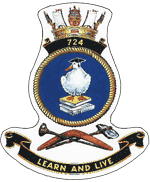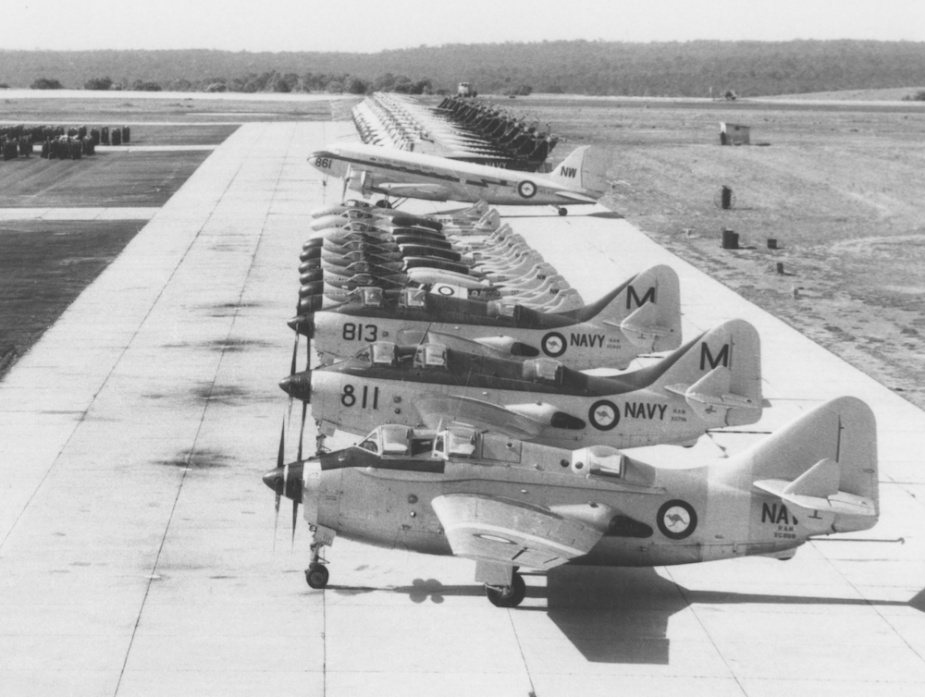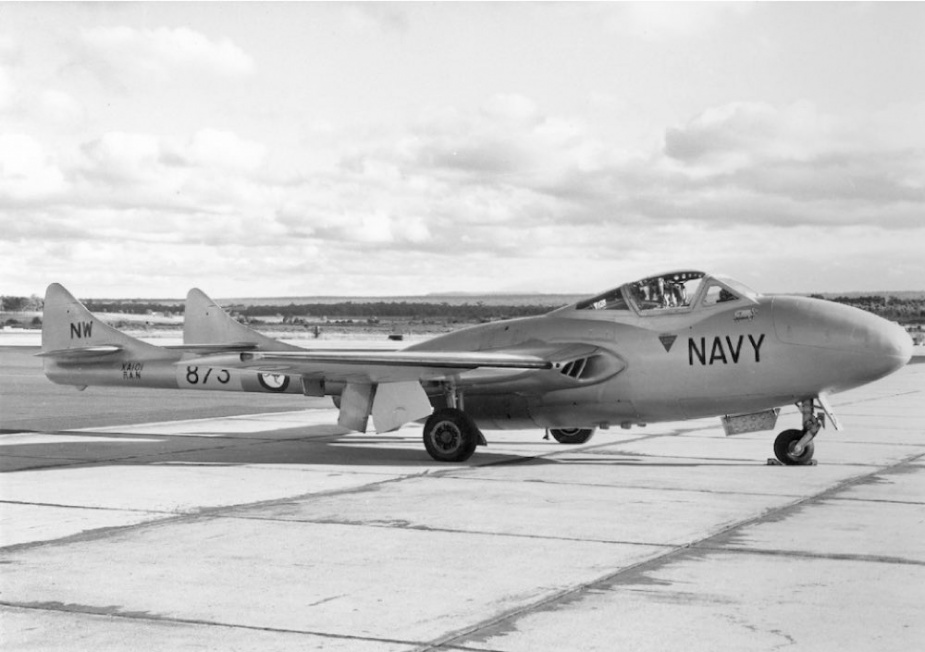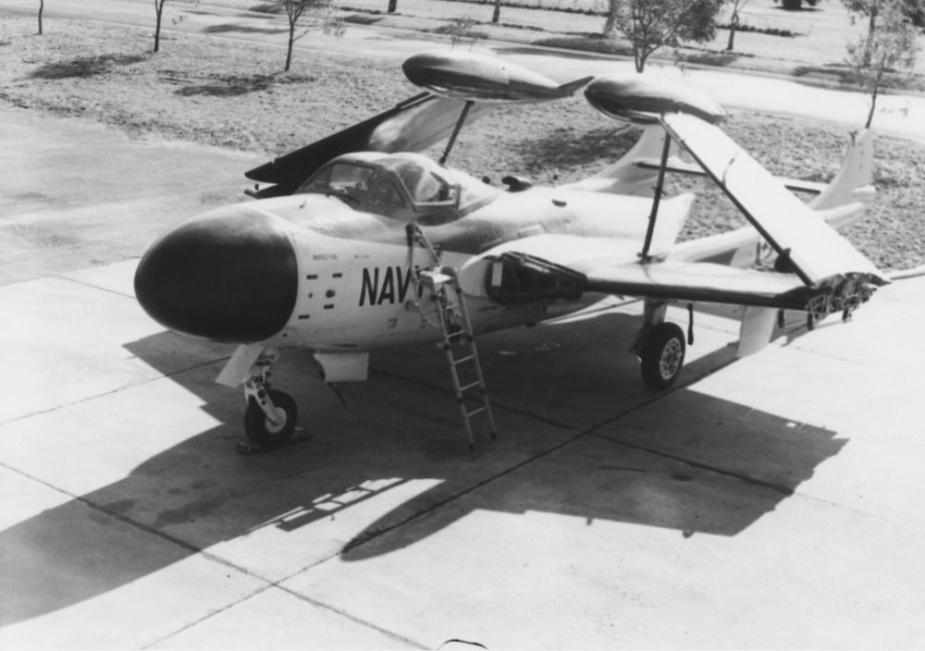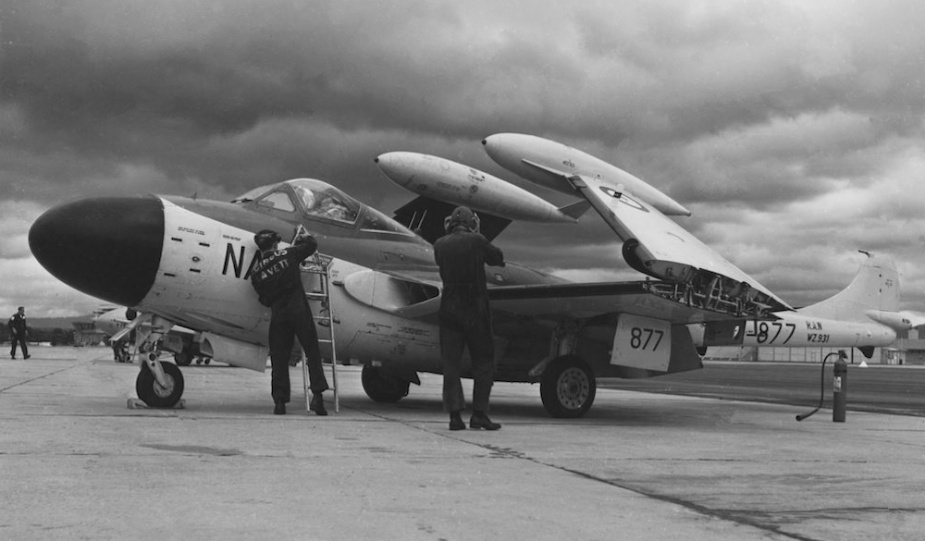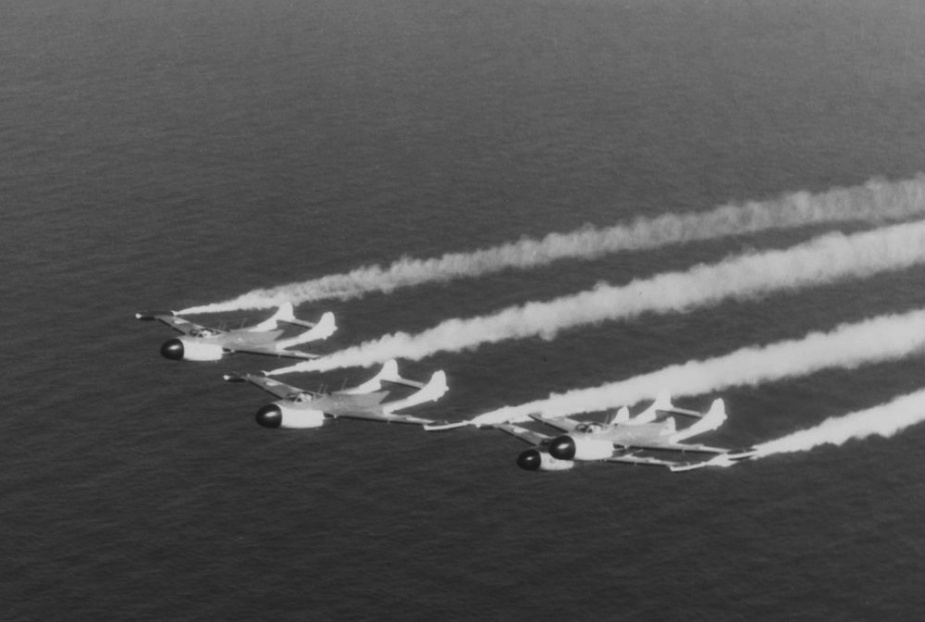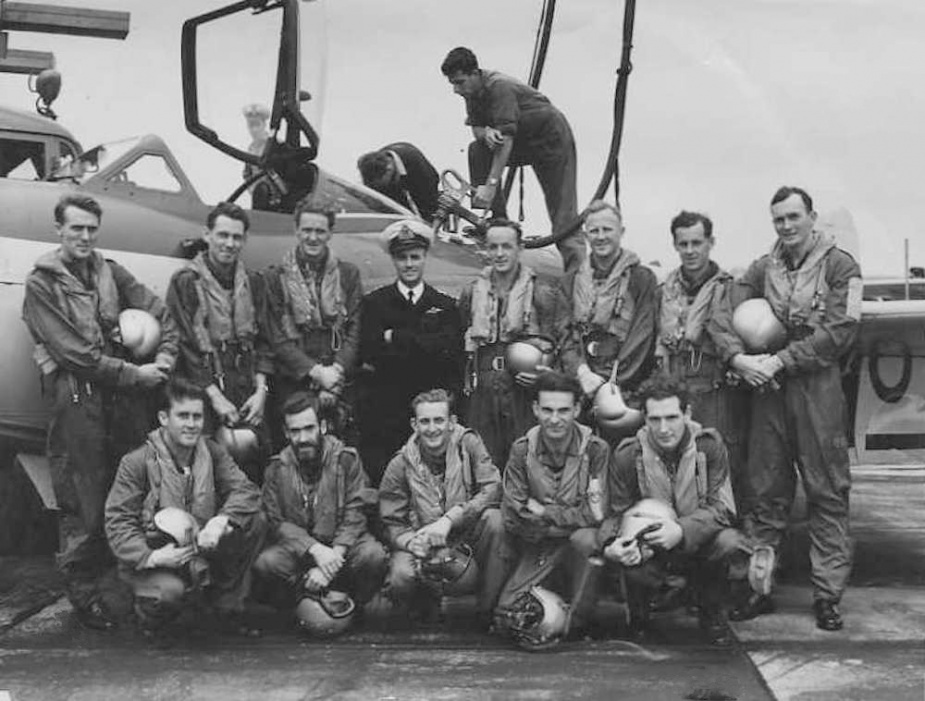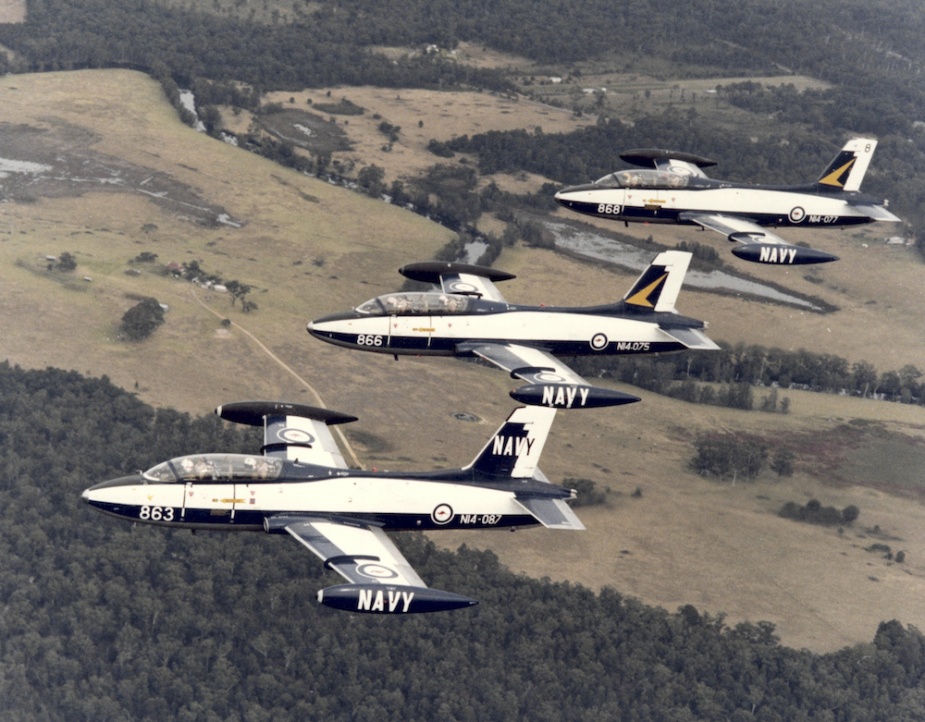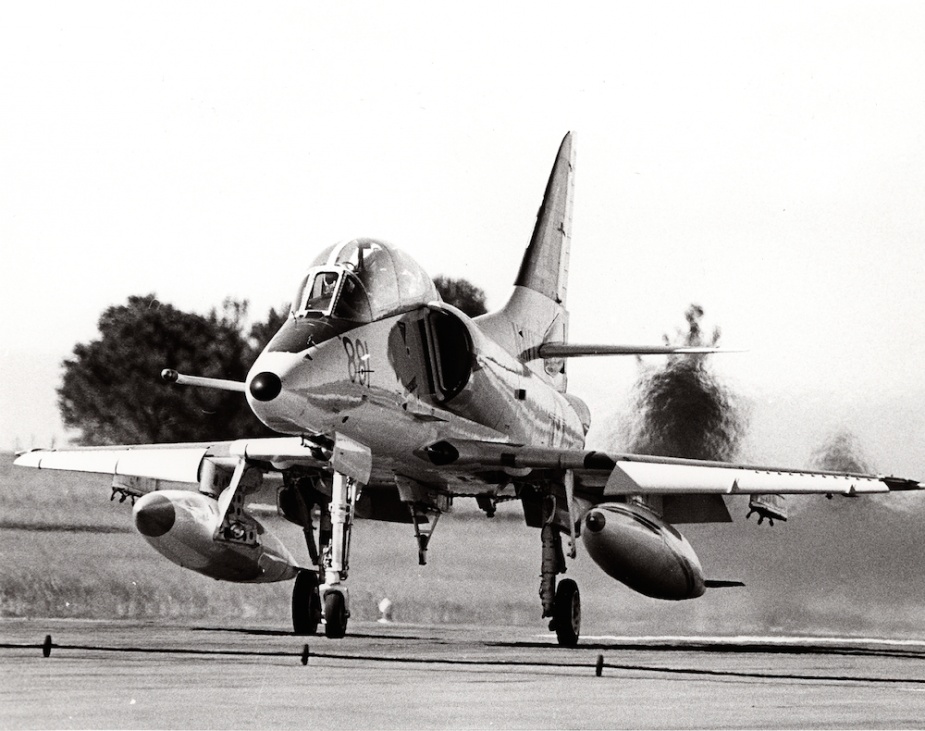724 Squadron History
724 Squadron has its origins in the Royal Navy (RN) where it was formed in Australia as a Naval Air Communications unit on 10 April 1945. The Squadron flew daily courier flights between Sydney and Melbourne before being disbanded on 31 May 1946 with the departure of the British Pacific Fleet.
724 Squadron recommissioned into the Royal Australian Navy (RAN) at Naval Air Station (NAS) Nowra on 1 June 1955 carrying out fixed wing conversion training for the Fleet Air Arm's (FAA) front line squadrons. Commanded by Lieutenant Commander Lionel Robinson, the squadron flew a variety of aircraft including Commonwealth Aircraft Corporation CA-16 Wirraways, Hawker Sea Fury Mark 11s, Fairey Firefly AS6s, and de Havilland Sea Vampire Mk T22s, and took delivery of three Fairey Gannet T2s in May the following year.
1956 proved to be a year of upheaval and tragedy for the squadron as three naval aviators perished in three separate accidents in 724 Squadron aircraft. Firstly, Sub Lieutenant Brian Howe was killed on 10 April when his Sea Fury crashed into the ground near NAS Nowra as he was returning from a night sortie. Lieutenant William Dunlop was the first RAN member to be killed in a Vampire when his aircraft suffered a mechanical failure and crashed, also at NAS Nowra, on 6 August. Finally, Commander Daniel Buchanan, Commander (Air) at HMAS Albatross, was also killed in a Vampire when his aircraft crashed into the sea off Greenwell Point near Nowra on 8 October.
In addition to these tragic events, the Squadron also experienced a major shift in the make up of its aircraft complement when, on 25 October 1956, it took on most of the decommissioning 723 Squadron aircraft, including its Bristol Sycamore HR 50/51 helicopters. The Sycamores were transferred back to the reconstituted 723 Squadron just four months later and most of 724 Squadron's fixed wing aircraft (except for the Gannets and Vampires) were transferred to 805 Squadron and 851 Squadron. In 1958, the Gannets were transferred to 725 Squadron and 724 Squadron became the FAA's first entirely jet aircraft squadron flying de Havilland Sea Vampire Mk T22s and De Havilland Sea Venom FAW Mk 53s.
Part of 724 Squadron's responsibility was to provide interception practice for Direction Officers training at HMAS Watson in the Radar Plot branch. The Squadron also provided aircraft for ships working up at sea near Jervis Bay performing varied tasks such as radar and communications calibration exercises through to mock attacks with multiple aircraft.
Early in 1958, the Squadron's Sea Venoms also started to provide targets for air-to-air live firing practice along with the Sea Furies and Fireflies. The Sea Venoms could tow target at speeds of up to 250 knots (over 460 kph) whereas the Sea Furies and Fireflies could only manage 140 knots (about 260 kph). The Sea Furies were decommissioned altogether in October 1962 and target towing was left to the Sea Venoms and Fireflies.
The Squadron also took advantage of the Sea Venom's display capabilities by putting together a formation aerobatic team in 1959 called the Ramjets. Led in its most successful early period by Leuitenant Commander Ian Josselyn, the Ramjets made the first jet formation aerobatic film in Australia and were a popular attraction at air shows around the country.
Another crash ensured that the last year of the 1950s was a sad one for the Squadron when a Sea Venom crashed into the sea off the NSW South Coast with the loss of two lives. The aircraft had taken off from NAS Nowra to carry out a low level photographic reconnaissance exercise on 20 May 1959. It was seen to circle the merchant vessel Komona before crashing into the sea around 30 kilometres east of Ulladulla. Both the pilot, Lieutenant Stanley Carmichael, and observer, Acting Sub Lieutenant Michael Williams were killed. Komona alerted naval authorities and made its way to the crash site but only the wing tip fuel tanks were recovered. The remains of the aircraft were discovered by the CSIRO fisheries research vessel Soela nearly 30 years later on 18 May 1988.
The upheaval experienced by the FAA in the early 1960s was reflected in 724 Squadron as the unit became something of repository for the FAA's fixed wing aircraft as fixed wing operations began to wind down. 725 Squadron decommissioned on 31 May 1961 followed by 805 Squadron on 30 June 1963. Those Squadrons' aircraft were transferred to 724 Squadron along with the fixed wing element of 723 Squadron in November 1963. The Squadron's aircraft complement had grown to include Sea Venoms, Gannets, Vampires, Fireflies, Douglas C47A Dakotas and Auster J5-G Autocars
By the end of 1963, 724 and 816 Squadrons were the only FAA Squadrons operating fixed wing aircraft until fixed wing operations recommenced in earnest in 1968. 724 Squadron's tasks had also expanded to include all weather fighter, Anti-Submarine Warfare (ASW) and operational flying training along with general fleet support, trials and communications tasks.
The Squadron became an all jet squadron once again in December 1968 flying Sea Vampires, Sea Venoms and the trainer variant of the newly acquired McDonnell Douglas A4G Skyhawk. In October 1970, the Squadron began taking delivery of the CAC Aermacchi MB-326H (Macchi) jet trainer. The Macchis were identical to those in use with the Royal Australian Air Force (RAAF) and procurement, spares and overhaul programs were all handled by the RAAF, an arrangement which worked very well. The Macchis completely replaced the Vampires and Sea Venoms by the end of 1970.
By that time the Squadron's roles had expanded to include operational flying training, fleet requirements, trials, missile firing, target towing and photo reconnaissance training. The RAN had also adopted United States Navy (USN) prefixes for its FAA Squadrons and 724 Squadron became VC724 Squadron indicating that it was officially designated a fixed wing composite unit.
Although it was nominally rated as a second line squadron, VC724 Squadron did participate in fleet exercises providing close air support to ground troops during large scale ground manoeuvres and also formed another aerobatic team in the early 1970s, this time with Skyhawks.
In spite of its commendable service, the future of fixed wing naval aviation remained in doubt throughout the late 1970s. The chances of acquiring a new carrier to replace HMAS Melbourne (II) when she paid off in the mid-1980s became increasingly thin and Naval Aviation's focus became firmly fixed on rotary wing and Vertical/Short Take-Off and Landing (VSTOL) aircraft. With Melbourne's decommissioning in June 1982 it was not long before the RAN's two front line fixed wing squadrons, VF805 and VS816, were disbanded at NAS Nowra on 2 July 1982. VC724 Squadron consequently absorbed VF805 into its complement and the Macchis were transferred to the RAAF 12 months later. VC724 squadron decommissioned at NAS Nowra on 30 June 1984 and the RAN's Skyhawks were sold to the Royal New Zealand Air Force.
Chronology of 724 Squadron history
|
Date
|
Event
|
|
10 Apr 1945
|
Formed as a RN squadron
|
|
31 May 1946
|
Disbanded
|
|
01 Jun 1955
|
Recommissioned into the RAN at NAS Nowra as a fixed wing conversion training unit with a variety of aircraft
|
|
13 Jan 1958
|
Becomes an all jet squadron flying Sea Vampires and Sea Venoms
|
|
31 May 1961
|
725 Squadron decommissions and its aircraft is transferred to 724 Squadron
|
|
30 Jun 1963
|
805 Squadron decommissions and its aircraft is transferred to 724 Squadron
|
|
Nov 1963
|
723 Squadron's fixed wing aircraft transferred to 724 Squadron
|
|
Dec 1968
|
Becomes an all jet squadron flying Sea Vampires, Sea Venoms and Skyhawks
|
|
Oct 1970
|
Begins taking delivery of Macchi jet trainers
|
|
1970
|
Sea Vampires and Sea Venoms paid off
|
|
30 Jun 1984
|
Decommissioned at NAS Nowra
|
Commanding Officers of 724 Squadron
|
Assumed Command
|
Commanding Officer
|
|
01 Jun 1955
|
Lieutenant Commander LA Robinson
|
|
25 Feb 1957
|
Lieutenant Commander PR Dallosso
|
|
01 Jul 1957
|
Lieutenant Commander KM Barnett
|
|
06 Aug 1957
|
Lieutenant Commander AG Cordell
|
|
01 Sep 1958
|
Lieutenant CE Champ
|
|
24 Nov 1958
|
Lieutenant Commander GJB Hanchard-Goodwin, RN
|
|
15 Feb 1959
|
Lieutenant Commander MW McD Barron, RN
|
|
20 Jul 1959
|
Lieutenant Commander GJB Hanchard-Goodwin, RN
|
|
09 Dec 1959
|
Lieutenant Commander IK Josselyn
|
|
31 Oct 1960
|
Lieutenant Commander MW McD Barron
|
|
03 Feb 1961
|
Lieutenant Commander NE Lee
|
|
04 Apr 1961
|
Lieutenant Commander RA Waddell-Wood
|
|
01 Jun 1961
|
Lieutenant Commander AE Payne
|
|
22 Jun 1962
|
Lieutenant Commander JP Van Gelder
|
|
15 Jul 1963
|
Lieutenant Commander A Ignatieff
|
|
01 Aug 1965
|
Lieutenant Commander MJ Astbury
|
|
23 Aug 1965
|
Lieutenant Commander KA Douglas, MBE
|
|
04 Dec 1967
|
Lieutenant Commander CMA Wheatley
|
|
02 Dec 1968
|
Lieutenant Commander JR Da Costa
|
|
28 Aug 1969
|
Lieutenant Commander WE Callan
|
|
21 Jul 1970
|
Lieutenant Commander GS King
|
|
21 Jul 1972
|
Lieutenant Commander BA Dutch
|
|
22 Oct 1973
|
Lieutenant Commander AM Hickling
|
|
17 Jan 1974
|
Lieutenant Commander G Heron
|
|
07 Jul 1975
|
Lieutenant Commander PC Marshall, AFC
|
|
04 Mar 1977
|
Lieutenant Commander D Collingridge
|
|
16 Jan 1978
|
Lieutenant Commander EM Kavanagh
|
|
11 Dec 1978
|
Lieutenant Commander CC Blennerhassett
|
|
11 Jan 1980
|
Lieutenant Commander BJ Daly
|
|
19 Dec 1980
|
Lieutenant Commander K Johnson
|
|
23 Aug 1982
|
Lieutenant Commander PL Clark
|
|
03 Dec 1983
|
Lieutenant Commander JM Hamilton, AFC
|
Further reading
- 'Flying Stations: A Story of Australian Naval Aviation', Australian Naval Aviation Museum, Allen & Unwin, St Leonards, 1998.
- 'Flying Squadrons of the Australian Defence Force', Steve Eather, Aerospace Publications, Canberra, 1995.
- 'Wings Across the Sea', Ross Gillett, Aerospace Publications, Canberra, 1988.


